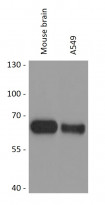ARG59988
anti-PSPC1 antibody
anti-PSPC1 antibody for IHC-Formalin-fixed paraffin-embedded sections,Immunoprecipitation,Western blot and Human,Mouse,Rat
Overview
| Product Description | Rabbit Polyclonal antibody recognizes PSPC1 |
|---|---|
| Tested Reactivity | Hu, Ms, Rat |
| Tested Application | IHC-P, IP, WB |
| Host | Rabbit |
| Clonality | Polyclonal |
| Isotype | IgG |
| Target Name | PSPC1 |
| Antigen Species | Human |
| Immunogen | Recombinant fusion protein corresponding to aa. 1-70 of Human PSPC1 (NP_001035879.1). |
| Conjugation | Un-conjugated |
| Alternate Names | Paraspeckle component 1; Paraspeckle protein 1; PSP1 |
Application Instructions
| Application Suggestion |
|
||||||||
|---|---|---|---|---|---|---|---|---|---|
| Application Note | * The dilutions indicate recommended starting dilutions and the optimal dilutions or concentrations should be determined by the scientist. | ||||||||
| Positive Control | Mouse brain and A549 | ||||||||
| Observed Size | 65 kDa |
Properties
| Form | Liquid |
|---|---|
| Purification | Affinity purified. |
| Buffer | PBS (pH 7.3), 0.02% Sodium azide and 50% Glycerol. |
| Preservative | 0.02% Sodium azide |
| Stabilizer | 50% Glycerol |
| Storage Instruction | For continuous use, store undiluted antibody at 2-8°C for up to a week. For long-term storage, aliquot and store at -20°C. Storage in frost free freezers is not recommended. Avoid repeated freeze/thaw cycles. Suggest spin the vial prior to opening. The antibody solution should be gently mixed before use. |
| Note | For laboratory research only, not for drug, diagnostic or other use. |
Bioinformation
| Database Links | |
|---|---|
| Gene Symbol | PSPC1 |
| Gene Full Name | paraspeckle component 1 |
| Background | This gene encodes a nucleolar protein that localizes to punctate subnuclear structures that occur close to splicing speckles, known as paraspeckles. These paraspeckles are composed of RNA-protein structures that include a non-coding RNA, NEAT1/Men epsilon/beta, and the Drosophila Behavior Human Splicing family of proteins, which include the product of this gene and the P54NRB/NONO and PSF/SFPQ proteins. Paraspeckles may function in the control of gene expression via an RNA nuclear retention mechanism. The protein encoded by this gene is found in paraspeckles in transcriptionally active cells, but it localizes to unique cap structures at the nucleolar periphery when RNA polymerase II transcription is inhibited, or during telophase. Alternative splicing of this gene results in multiple transcript variants. A related pseudogene, which is also located on chromosome 13, has been identified. [provided by RefSeq, Aug 2011] |
| Function | Regulates, cooperatively with NONO and SFPQ, androgen receptor-mediated gene transcription activity in Sertoli cell line (By similarity). Binds to poly(A), poly(G) and poly(U) RNA homopolymers. Regulates the circadian clock by repressing the transcriptional activator activity of the CLOCK-ARNTL/BMAL1 heterodimer (By similarity). Together with NONO, required for the formation of nuclear paraspeckles. [UniProt] |
| Cellular Localization | Nucleus, nucleolus. Nucleus matrix. Cytoplasm. Nucleus speckle. Note=In punctate subnuclear structures often located adjacent to splicing speckles, called paraspeckles. Colocalizes with NONO and SFPQ in paraspeckles and perinucleolar caps in an RNA-dependent manner. May cycle between paraspeckles and nucleolus. In telophase, when daughter nuclei form, localizes to perinucleolar caps. [UniProt] |
| Calculated MW | 59 kDa |
Images (1) Click the Picture to Zoom In






